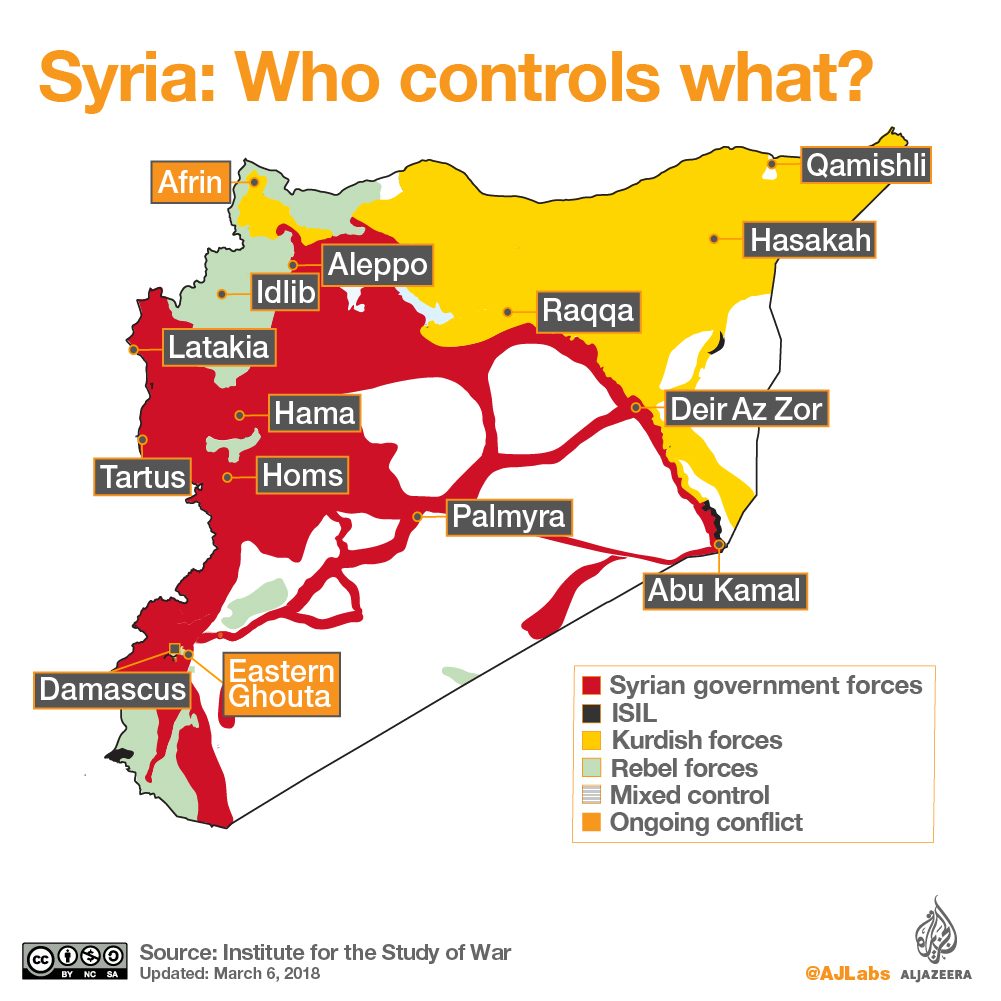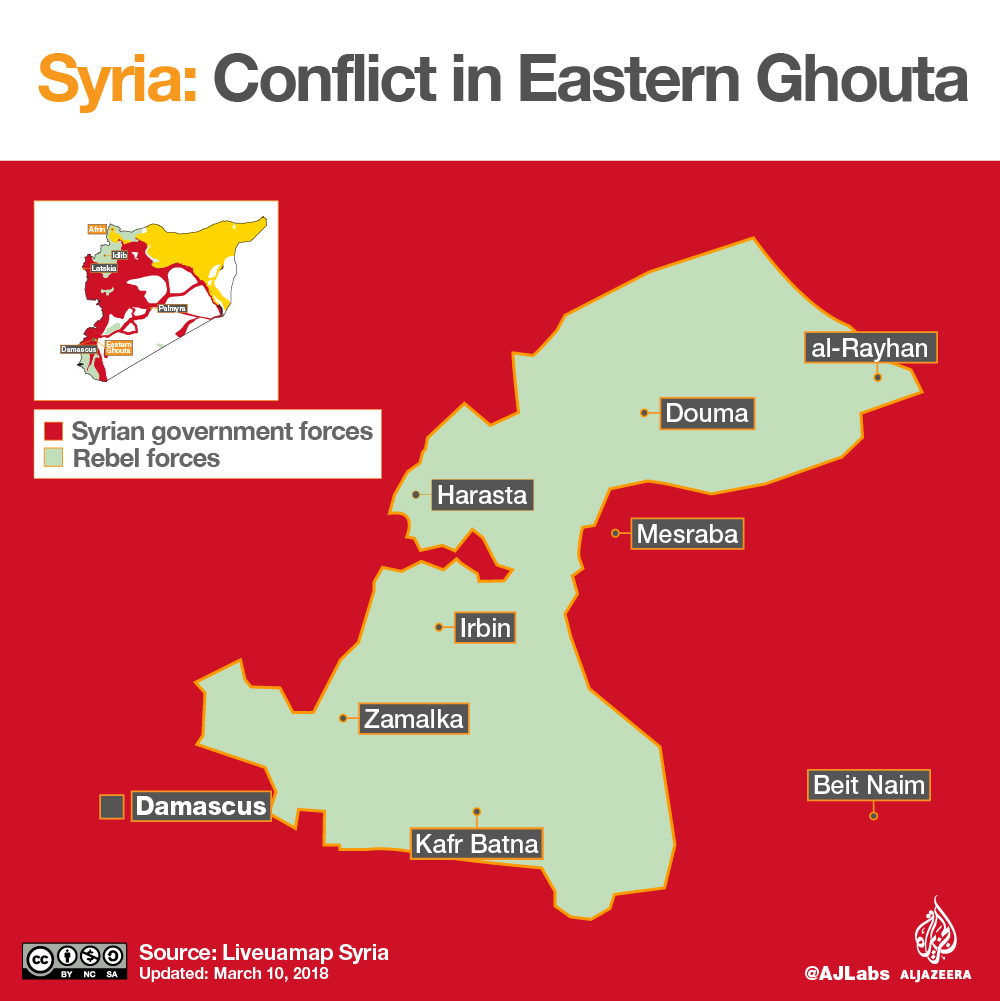Home » Middle East »
Syria's war: Battles rage in Eastern Ghouta, as 'toll tops 1,000'
Syria’s army and rebel groups locked in battle, as civilian death toll hits 1,099, according to UK-based war monitor.
The Syrian army and rebel groups early on Sunday engaged in fierce battles in Eastern Ghouta, where fighting has killed at least 1,099 civilians over the past 21 days, a war monitor said.
The death toll, recorded by the Syrian Observatory for Human Rights (SOHR) – a UK-based war monitoring group – included 227 children and 154 women. At least 4,378 others were wounded.
“Warplanes covered the sky in Eastern Ghouta yesterday,” Abdelmalik Aboud, an activist in the town of Douma, told Al Jazeera on Sunday.
“The shelling was focused on the underground shelters and mosques and the places that people have tried to hide in, due to the constant bombardment,” he added.
The rising toll comes amid claims of yet another chemical attack overnight on the town of Arbin in Eastern Ghouta, a suburb of the capital, Damascus.
The Syrian Civil Defence, a volunteer rescue group also known as the White Helmets, said the Syrian government hit Irbin with chlorine gas, phosphorus bombs and napalm.
This is the second alleged chemical attack in a matter of days.
On Wednesday night, activists in residential the town of Hamouriyah released videos appearing to show phosphorus bombs being dropped and many victims struggling to breathe.
Syria’s Deputy Foreign Minister Faisal Mekdad denied the reports during a press conference in Damascus on Thursday.
Mekdad said “terrorists” controlling the area and those who support them should be held accountable.
Latest offensive
Eastern Ghouta has been under control of armed opposition groups since 2013 – two years into a popular uprising in Syria calling for the removal of President Bashar al-Assad.
With Russia’s intervention in 2015, Assad’s forces have been able to regain most of the rebel-held territory, but Eastern Ghouta remains one of the last armed opposition strongholds.
The area, home to some 400,000 people, has been under a suffocating siege by government forces since 2013, in an attempt to drain the armed opposition operating there.
Government forces, aided by a Russian aerial campaign, have managed to make major advances into the territory since the start of the latest offensive on February 18.
On Saturday, Syrian forces captured the largest town in Eastern Ghouta – Mesraba – effectively splitting the rebel-held enclave in three.
In addition to capturing Mesraba, government forces have also encircled the towns of Douma and Harasta, deep inside the enclave.
Aboud, the activist inside Douma, said many people were afraid.
“They are afraid of the government advance because they know that the regime is spiteful of Douma and Eastern Ghouta,” said Aboud.
Syrian state media says government forces now control 51 percent of Eastern Ghouta.
“Encircling towns is something Syrian government forces have done consistently,” Al Jazeera’s Alan Fisher, reporting from Gaziantep on the Syrian-Turkish border, said.
“By cutting off roads and important supply lines, they’ve essentially left the fighters with no place to go,” he added.
The Syrian government’s offensive follows a pattern of previous assaults on opposition strongholds, deploying massive air power and tight sieges to force rebel fighters to accept “evacuation” deals.
These involve rebels surrendering territory in exchange for safe passage to opposition areas in northwest Syria, along with their families and other civilians who do not want to come back under Assad’s rule.
On Friday, a number of rebel fighters were evacuated from Eastern Ghouta.
Jaish al-Islam, one of the main rebel groups in Eastern Ghouta, announced it had agreed to the evacuation of several Hay’et Tahrir al-Sham fighters – previously part of the al-Qaeda-linked al-Nusra Front – who were detained by the group in Eastern Ghouta.
According to Syrian state media, 13 fighters were evacuated with their families through the al-Wafeedin passage and bussed to Idlib province.
Marwan Kabalan, a Doha-based Syrian analyst, says the deal is part of Assad’s strategy to divide and conquer.
“He’s isolating the two big cities [Douma and Harasta] in Eastern Ghouta – he’s weakening them and he’s supporting this military approach through a political strategy – separating them on the ground while trying to strike a deal with Jaish al-Islam,” Kabalan told Al Jazeera.
‘Verge of major disaster’
The United Nations’ refugee agency representative to Syria, Sajjad Malik, entered the town of Douma in Eastern Ghouta on Monday accompanying an aid convoy.
When asked what he saw in Eastern Ghouta, Malik said the area was “on the verge of a major disaster”.
“You walk in that town and you see destruction, you see displacement. There are dead bodies still in destroyed buildings. The smell is very strong in those areas,” he said.
“There are people who are living in overcrowded basements. People coming out of those basements when we were there – it’s hard to describe them. Their pale skin, you could see rashes on their skin, you can see that they’re stunted.”
Source: Read Full Article




